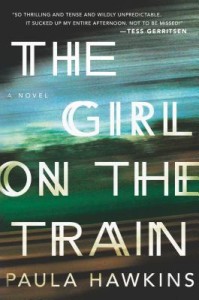Hawkins, Paula. The Girl on the Train
New York: Penguin Group, 2015
ISBN 978–1–59463–366–9
 Rachel rides the same train every day on her commute to and from London, right past the street where she and her husband used to live. She’s still reeling with despair over the failure of her marriage two years earlier. Looking at their house, where her husband now lives with his new wife and their baby, is too painful, so Rachel concentrates on a house a bit down the street. Every day she observes the couple living there, a golden couple, as she thinks of them: happy and loving, comfortable with each other. Rachel fantasizes about the couple, whom she calls Jess and Jason, imagining their sophisticated careers and their perfect life together.
Rachel rides the same train every day on her commute to and from London, right past the street where she and her husband used to live. She’s still reeling with despair over the failure of her marriage two years earlier. Looking at their house, where her husband now lives with his new wife and their baby, is too painful, so Rachel concentrates on a house a bit down the street. Every day she observes the couple living there, a golden couple, as she thinks of them: happy and loving, comfortable with each other. Rachel fantasizes about the couple, whom she calls Jess and Jason, imagining their sophisticated careers and their perfect life together.
We learn early on that Rachel really is an emotional wreck. She’s still living in a college friend’s spare bedroom, where she crashed after the break-up of her marriage—just until she could find a place of her own. And she’s an alcoholic, a fall-down drunk subject to blackouts and lost memories. It’s no wonder she’s so obsessed with Jess and Jason’s perfect life. So when she sees something out of the ordinary going on in their back yard one day, she can’t keep herself from getting involved.
Rachel is the book’s main narrator, but there are also two other women whose viewpoint we occasionally see. As with most cases of multiple perspectives, discovering the truth requires the reader to triangulate the three narratives. The novel’s main theme is love and marriage, but equally important is the theme of control, over both one’s self and one’s life.
This book is often touted as a good read for fans of Gillian Flynn’s Gone Girl, which is the reason why I picked it up. Like Flynn’s novel, The Girl on the Train is a twisted love story. But it’s not nearly as tightly written or as compellingly crafted as Gone Girl. Rachel is so overdrawn that it’s hard to believe some of her outrageous actions, even given the circumstances of her life. The use of drunken blackouts and memories that tantalize and then retreat just out of reach is a convenient and common literary technique. And anyone who reads the book even half carefully will most likely figure out the catch well before the big revelation at the end.
Update
There’s an interesting article on Hawkins and The Girl on the Train here. Writer Alexandra Alter offers this insight into the runaway success of Hawkins’s novel:
American crime fiction travels easily abroad; the converse is less often true, unless the author happens to be a J. K. Rowling or a Lee Child. But “The Girl on the Train” may have benefited from a wave of popular and unconventional suspense novels that have eroded the already thin boundary between literary fiction and thrillers. Ms. Hawkins joins the ranks of a new generation of female suspense novelists — writers like Megan Abbott, Tana French, Harriet Lane and Gillian Flynn — who are redefining contemporary crime fiction with character-driven narratives that defy genre conventions. Their novels dig into social issues, feature complex women who aren’t purely victims or vixens, and create suspense with subtle psychological developments and shifts in relationships instead of procedural plot points and car chases.

